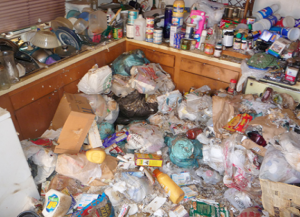 Firefighter-Paramedic Ryan Pennington with the Charleston (WV) Fire Department has been conducting extensive research on the epidemic problem of emergencies in hoarder homes. Emergencies including everything from fires to EMS calls to animal hoarding issues – the whole gamut. Ryan has also developed a knock-out program on hoarder home fires. If your jurisdiction is having problems with hoarder home fires, Ryan’s program may be just what you need. Let’s see what Ryan has to say in this guest article on “Heavy Content” Hoarder Homes.
Firefighter-Paramedic Ryan Pennington with the Charleston (WV) Fire Department has been conducting extensive research on the epidemic problem of emergencies in hoarder homes. Emergencies including everything from fires to EMS calls to animal hoarding issues – the whole gamut. Ryan has also developed a knock-out program on hoarder home fires. If your jurisdiction is having problems with hoarder home fires, Ryan’s program may be just what you need. Let’s see what Ryan has to say in this guest article on “Heavy Content” Hoarder Homes.
Good afternoon and thank you for the opportunity to guest post on SAMatters! I would like to take this opportunity to speak to you, the loyal readers of SAmatters, on Hoarder House Fires. Educating firefighters on the dangers associated with hoarder fires has become my passion, so when Dr. Gasaway offered, I jumped at the chance to share a lesson in hoarding with you. So let’s go into the chamber of hoarders for an article on using the term “heavy contents” while battling a Hoarder Homes fires.
Hoarder Home Size-Up
 The duty of the first arriving officer is to size up the situation accurately. During this process they will use their senses to form a plan of attack by walking around the structure. During your size up you will need to pay close attention to windows, front yards, porches, and entry ways for signs of hoarded interiors. If you make this determination you need to announce “Heavy Contents” to everyone on scene and responding to tell them of the conditions. It’s kind of ironic that I am writing about the use of this term for Dr. G’s website as he was instrumental in developing it. You see he is the brain science professor that helped me realize the meaning behind these two terms placed beside each other.
The duty of the first arriving officer is to size up the situation accurately. During this process they will use their senses to form a plan of attack by walking around the structure. During your size up you will need to pay close attention to windows, front yards, porches, and entry ways for signs of hoarded interiors. If you make this determination you need to announce “Heavy Contents” to everyone on scene and responding to tell them of the conditions. It’s kind of ironic that I am writing about the use of this term for Dr. G’s website as he was instrumental in developing it. You see he is the brain science professor that helped me realize the meaning behind these two terms placed beside each other.
The Origins of Hoarding
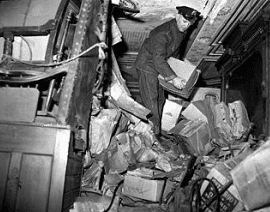 We all have terms that we use to describe a hoarded home. From “trash house” to “Collier’s Mansions”, a term derived from the Collier brothers in Manhattan. They made hoarding famous or should I say infamous. We have used multiple versions of describing the same thing. These words have the same meaning behind them but can be harmful to the owners of the homes if they are standing beside one of our radios when the report gets to command. You see, people who live in hoarded conditions have an emotional attachment to their “stuff.” A simple stack of newspapers to you might have a deep emotional meaning for them. You can see how it might cause a problem if they overheard radio traffic describing their belongings as “trash” or their home as a “trash house.” If you choose to use “Collier’s Mansion” terminology you will need to make sure that everyone who might respond to your scene has a true understanding of its meaning.
We all have terms that we use to describe a hoarded home. From “trash house” to “Collier’s Mansions”, a term derived from the Collier brothers in Manhattan. They made hoarding famous or should I say infamous. We have used multiple versions of describing the same thing. These words have the same meaning behind them but can be harmful to the owners of the homes if they are standing beside one of our radios when the report gets to command. You see, people who live in hoarded conditions have an emotional attachment to their “stuff.” A simple stack of newspapers to you might have a deep emotional meaning for them. You can see how it might cause a problem if they overheard radio traffic describing their belongings as “trash” or their home as a “trash house.” If you choose to use “Collier’s Mansion” terminology you will need to make sure that everyone who might respond to your scene has a true understanding of its meaning.
Heavy Contents
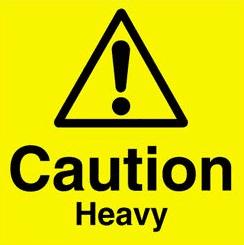 That is why I developed the term Heavy Contents. It is politically correct, accurate, and should trigger your brain to start thinking of the increased weight that is added to the structure, even before the first drop of water hits the ground. Hoarded homes often have so much stuff in them that normal living spaces become uninhabitable. If the belongings are occupying that amount of space imagine how much extra weight has been added onto the structure. This is where the term Heavy comes in. A large amount of belongings equals a large amount of weight and it is a term that anyone can relate to, even if they haven’t been taught it, due to the use of common terminology.
That is why I developed the term Heavy Contents. It is politically correct, accurate, and should trigger your brain to start thinking of the increased weight that is added to the structure, even before the first drop of water hits the ground. Hoarded homes often have so much stuff in them that normal living spaces become uninhabitable. If the belongings are occupying that amount of space imagine how much extra weight has been added onto the structure. This is where the term Heavy comes in. A large amount of belongings equals a large amount of weight and it is a term that anyone can relate to, even if they haven’t been taught it, due to the use of common terminology.
Property Maintenance
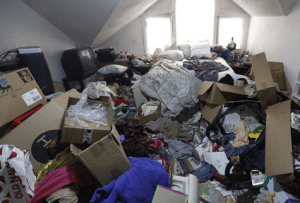 Another complication inside a hoarded home is the lack of property maintenance. Hoarder conditions make it almost impossible to reach all the points of the structure from leaking pipes, busted ceilings, finding termites, or noticing a leaking exterior wall leading to weakened structural members. This is troubling to us, as firefighters, due to the chances of structural collapse being increased, often without us knowing. This is just another reminder that if we hear the term heavy content called out, that we should automatically think of increased collapse risks.
Another complication inside a hoarded home is the lack of property maintenance. Hoarder conditions make it almost impossible to reach all the points of the structure from leaking pipes, busted ceilings, finding termites, or noticing a leaking exterior wall leading to weakened structural members. This is troubling to us, as firefighters, due to the chances of structural collapse being increased, often without us knowing. This is just another reminder that if we hear the term heavy content called out, that we should automatically think of increased collapse risks.
Piled High and Deep
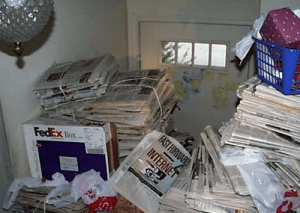 The second of the two words should warn you of the dangers that lie inside. With hoarder homes you can face belongings that can reach all the way to the ceiling. Add in a fast-moving fire with thick dark smoke and it’s a recipe for your death. If you hear the call of heavy content you need to go to a defensive mindset. Not so much that you need to abandon interior operations, although that would be a wise decision many times, but you need to be more careful in selecting your point of entry, hand tools, and absolutely do not enter without a thermal imagining camera and a hose or search rope to help aid in your exit. In a hoarder home, the right and left hand searches are basically useless due to the inability to use the walls. Your only link to the outside is that hose or search line if your TIC batteries fail.
The second of the two words should warn you of the dangers that lie inside. With hoarder homes you can face belongings that can reach all the way to the ceiling. Add in a fast-moving fire with thick dark smoke and it’s a recipe for your death. If you hear the call of heavy content you need to go to a defensive mindset. Not so much that you need to abandon interior operations, although that would be a wise decision many times, but you need to be more careful in selecting your point of entry, hand tools, and absolutely do not enter without a thermal imagining camera and a hose or search rope to help aid in your exit. In a hoarder home, the right and left hand searches are basically useless due to the inability to use the walls. Your only link to the outside is that hose or search line if your TIC batteries fail.
In closing I would like to thank Dr. G for giving me the guidance over the past 20 plus years and the chance to share an article on hoarder home fires with you. You should read this article, return to your department, and share the term “heavy content” with anyone who may respond to a hoarded home in an emergency. It should hammer home the importance that it’s not a basic fire anymore. Hoarded houses can put you at a higher risk that needs to be identified and adjusted for immediately upon the discovery of heavy content’s. Using a term developed with Dr. G’s brain science will hammer home to your people the need and, hopefully, make you remember this article. Just remember that SA does matter and before you go into your next fire maybe you should spend some time reading Chamber of Hoarders (www.Chamberofhoarders.com) so you will be ready to face the Heavy Contents inside your next hoarder home fire.

Dr. Gasaway’s Advice
Hoarder homes present special challenges for first responders, including fire, EMS and police. The hoarded environment is especially dangerous because of the heavy loads, the unpredictability of the contents and the limited ingress and egress. Hoarder home emergencies cannot be treated the same as non-hoarded homes. Thanks, Ryan, for taking the lead on this critically important topic.
Situational awareness starts with capturing clues and cues that are the foundation of knowing what is going on. In a hoarded environment, those clues and cues are going to be different – maybe even bazaar. There may be indicators outside the house (often there is) but you may not know it until you make entry and then get the surprise of your life.
 Action Items
Action Items
1. Discuss hoarder home calls that you have been on and what you encountered that made the call more difficult.
2. Discuss the clues and cues that indicate the home is a hoarder home.
3. Discuss alternate strategies for getting your work done safely.
_____________________________________________________

If you are interested in taking your understanding of situational awareness and high-risk decision making to a higher level, check out the Situational Awareness Matters Online Academy.
CLICK HERE for details, enrollment options and pricing.
__________________________________
Share your comments on this article in the “Leave a Reply” box below. If you want to send me incident pictures, videos or have an idea you’d like me to research and write about, contact me. I really enjoy getting feedback and supportive messages from fellow first responders. It gives me the energy to work harder for you.
Thanks,

Email: Support@RichGasaway.com
Phone: 612-548-4424
SAMatters Online Academy
Facebook Fan Page: www.facebook.com/SAMatters
Twitter: @SAMatters
LinkedIn: Rich Gasaway
Instagram: sa_matters
YouTube: SAMattersTV
iTunes: SAMatters Radio
iHeart Radio: SAMatters Radio

Pingback: Guest appearance on SAMatters.com | Chamber of Hoarders
Great comments and thoughts by Ryan. Having ” worked” a number of these types of fires the content is definitely heavy. Add to the contents the possible hundreds or thousands of gallons of water and you definitely have the potential for structural collapse.
Company officers definitely need to be aware of the signs identifying signs of hoarding. Early identification and communication to the crews is vital. Stretching lines is difficult at best and searching is even worse.
One of my earliest fires was in a two story structure that was filled to the brim with one foot wide isle ways to try to navigate through. Every time you tried to turn, I knocked something over with my SCBA causing conditions to get even worse. Several times I got entangled in the mounds of “stuff” in the rooms while trying to do a search.
Great Job on what is becoming a more frequent issue.
Chief Williams,
Thank you for sharing your experience with me and for sharing your kind comments about Ryan’s story. He is fast becoming the nation’s go-to expert on public safety hoarder issues. He’s done some amazing research on this and is developing drills to help responders. He also has a classroom program that really gets responders dialed in. He caught my attention with it. Now we need to get his message out to others.
Rich
Chief Williams,
Thank you for commenting on this serious condition. Hoarding presents a huge challenge to firefighters and in my research I hear the word “luck” or “we got lucky” excessively. It is my passion to share what I have learned so we don’t depend on luck, we need to depend on hoarder awareness and education. Hoarded homes are NOT bread and butter fires. They are complex, challenging, and dangerous firefighter killers that need identified, communicated, and tactically changed. The weight is one of the biggest challenges; now throw in the load of a hoarder in a lightweight wood frame and this could possibly be the most dangerous fire we could face. Thank you for contributing to this discussion. I would love the chance to share more of my research with your department.
Sincerely,
Ryan Pennington
Just encountered my first hoarder home in Northern Virginia. This article was very informative in how to better approach the situation next time.